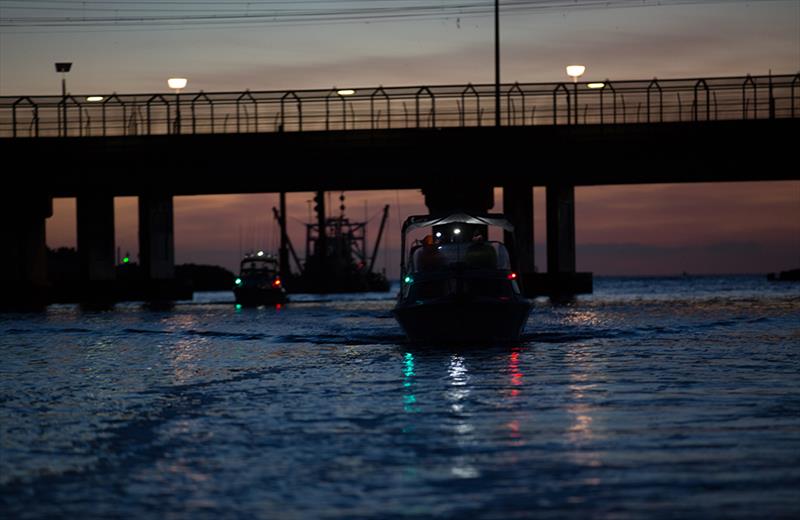
Safety Alert: Navigation lights
by Maritime Safety Victoria 14 Feb 2019 23:56 UTC

Boats with navigation lights © Maritime Safety Victoria
There have been recent collisions directly attributable to the incorrect placement of navigation lights and /or vessels displaying navigation lights that do not comply with the Marine Safety Regulations 2012 (Vic) (MSR).
Navigation lights don't just make you visible, they also tell other people something about the type of vessel you have and what course you are on relative to the observer.
TSV and Victoria Police are increasingly encountering vessels that have lights installed incorrectly.
Two common errors are:
- Sidelights that are designed to be mounted on a vertical surface are installed on a horizontal surface (see picture)
- All-round white lights are installed too low down so that they can obscure the sidelights, dazzle the person at the helm, or the light itself is obscured by the superstructure or occupants of the vessel.
Risk
Incorrectly installed lights can have a number of effects:
- Your vessel may be invisible to other vessels
- Your vessel's course and orientation may be unclear to other people
- Your own view from the helm may be compromised by poorly placed lights.
The MSR sets out the requirements for vessels to display the correct lights when operating between sunset and sunrise and at times of restricted visibility. These requirements are consistent with the International Regulations for Preventing Collisions at Sea 1972 (known as Collision Regulations, or COLREGs) for displaying lights on vessels.
LED lighting strips do not comply with the Collision Regulations, and are unlawful.
Penalties of up to $3000 exist for failing to display navigation lights correctly.
Maritime Safety Victoria advice
Vessel owners and operators should check their navigation lights, and if unsure have them examined by a suitably qualified person to ensure that they meet the regulatory requirements.
Regulatory requirements
Powered vessels less than 12 metres in length must display the following lights:
Sidelights
A red port and green starboard light. These are sector lights, meaning they must be visible in a horizontal plane in an unbroken arc of 112.5 degrees.
The arc must stretch from straight ahead to 22.5 degrees abaft the beam on the port (red) and starboard (green) sides. To achieve a proper horizontal arc of light these light units must be mounted on an appropriate surface.
Generally, they are designed to be mounted on either a horizontal surface, or on a vertical surface that is parallel to the centre line of the vessel.
If no such surface exists in the correct location, then one must be created by packing or other means.
All-round white light
A light visible for 360 degrees around the vessel
Masthead Light
A white light on the centre line of the vessel showing an unbroken light from right ahead to 112.5 deg aft on each side
Stern Light
White light placed at the stern visible for 67.5 deg from right aft each side
Vertical Separation
The masthead light and all-round white light must be at least one metre higher than the sidelights and should be positioned so that it is not obscured by anything on or in the vessel.
Additionally, they should be placed so that they do not dazzle the person at the helm.
To achieve this, it may be more appropriate to have the separate masthead and stern light combination rather than a single all-round light, depending on the type of vessel.
Display of lights
At anchor, only the all-round white (anchor) light is to be shown. With no red and green lights displayed, it is made clear that the vessel is not under way and is unlikely to be a give-way vessel.
When under way, sidelights and the white light/s must be displayed. An all-round white light may be used as an alternative to the masthead and stern light combination when under way however, it must be visible for 360 degrees. If a masthead light and a stern light are displayed, they must also not be obscured and in effect be visible from all around the vessel.
An overtaking vessel will see a white light only. They are the give way vessel if you are under way as well as if you are at anchor. A white light could be a stern light, an all-round white light or a torch. In all cases it indicates a vessel or object to avoid. The intent of the Collision Regulations is that a white light visible in isolation indicates a vessel to avoid. You must have a white light (all-round or masthead and stern light combination) displayed in addition to your side lights if you are under way.
When sidelights are displayed, they must not overlap across the bow or be obscured by hand rails or other structures.
You should avoid additional lighting such as light bars if it masks your navigation lights, or if they may dazzle you. It is an offence to dazzle the operators of other vessels. Light bars should never be used while navigating.
LED lighting strips do not comply with the Collision Regulations and should not be used as substitutes for navigation lights.
Learn more about nav lights here.